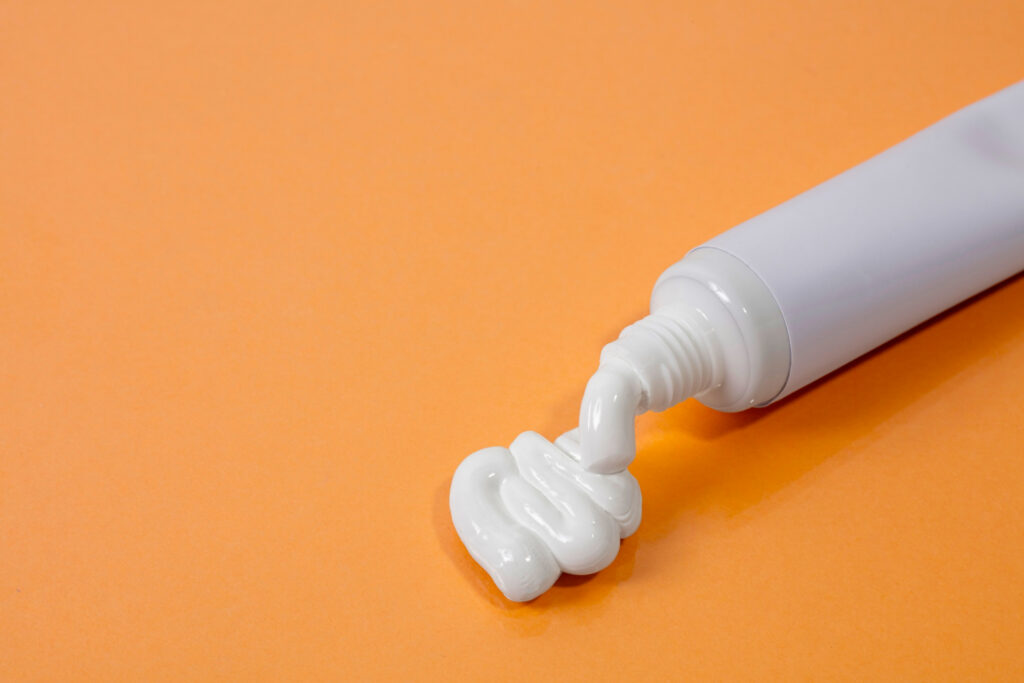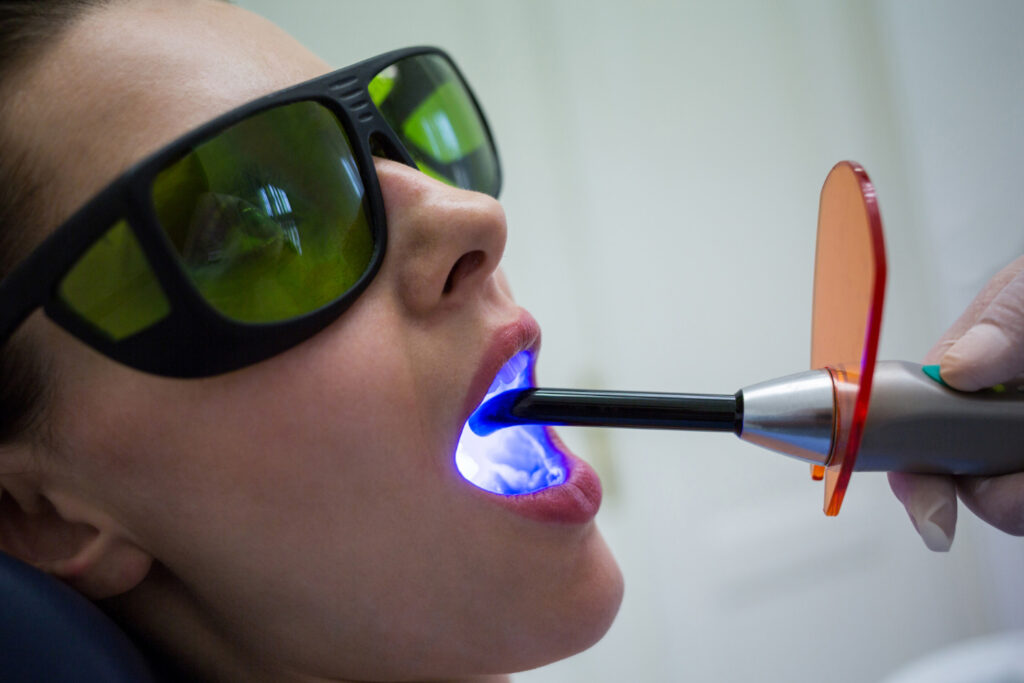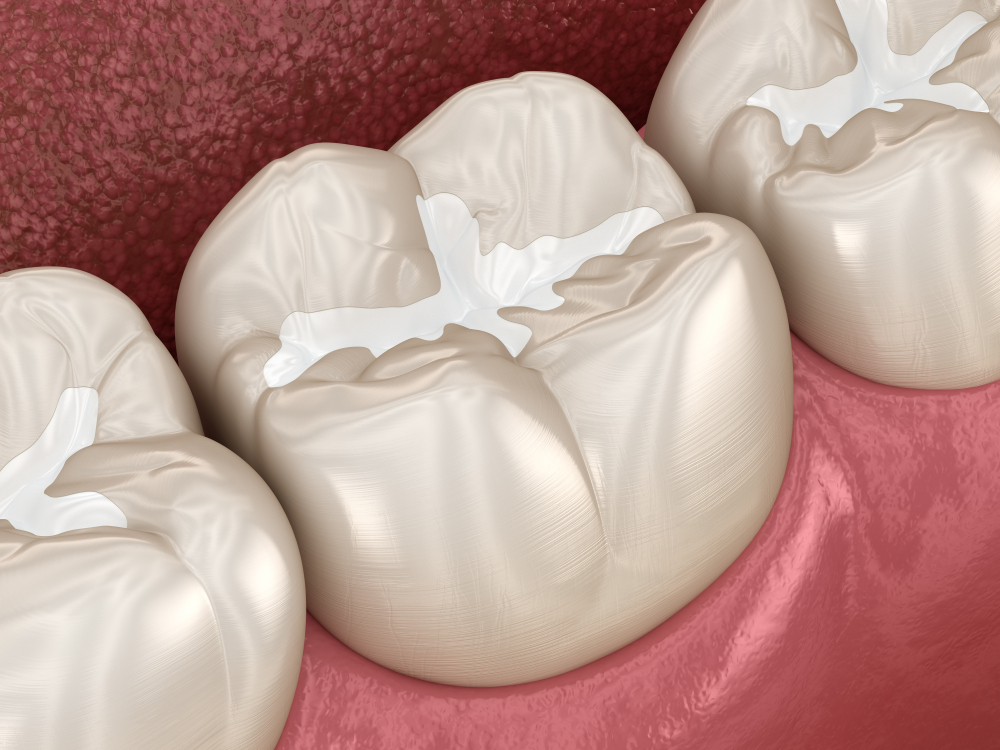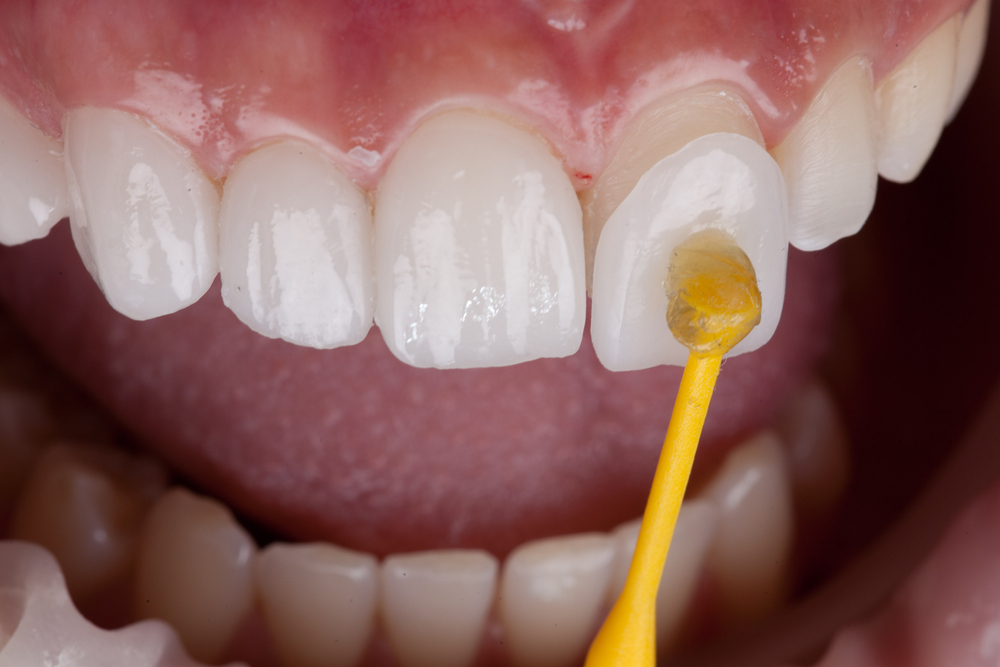Dental health is more than just about maintaining a bright, sparkling smile. It also involves taking preventive measures to guard your teeth against potential damage. One of these preventive measures gaining momentum in the field of dentistry is the application of dental sealants.
Dental sealants are essentially an invisible shield for your teeth. They are a thin, protective coating that adheres to the surface of your back teeth – particularly the molars and premolars, which are notoriously difficult to clean thoroughly. The grooves and depressions on these teeth, known as pits and fissures, are the perfect hiding spots for food particles and plaque, making them hotspots for cavities.
It’s easy to miss these spots during brushing, even with meticulous oral hygiene. Dental sealants fill these pits and fissures, making the surface of the teeth smoother and easier to clean, and essentially shutting out the plaque and bacteria. As such, dental sealants act as a barrier, preventing cavities and preserving the integrity of the teeth.
Our Philosophy
Dr. Dawson and Dr. Turke at Smile Science Dental Spa in Glendale, AZ, apply dental sealants as part of their proactive approach to oral health. They view dental sealants as an investment, an effective way to reduce the risk of more costly and invasive dental procedures down the line. Dental sealants, in this sense, are not only a form of physical protection but also a peace of mind, knowing that your teeth have that extra layer of defense against cavities.
As parents, we are always looking for ways to protect our children. The good news is that dental sealants aren’t just for adults. They are especially beneficial for children who are still mastering their oral hygiene habits. By sealing off the grooves on the molars and premolars, we reduce the risk of these teeth developing cavities. In other words, dental sealants could be a game-changer for your child’s oral health.
What Are Dental Sealants Made Of?

Understanding what goes into your body is an essential part of healthcare. In dentistry, one common question patients have is about the materials used in their treatment. If you’ve been contemplating getting dental sealants, you may be wondering, what are they made of?
Dental sealants are primarily made of a plastic material known as resin. The resin used for dental sealants is specifically designed to be safe, effective, and durable. This material can either be clear or slightly white or tooth-colored, making it almost invisible once applied to the teeth. The color of the sealant material can be a great advantage, especially for those who are concerned about maintaining a natural-looking smile.
Flexible
The resin material is very flexible, allowing it to mold perfectly into the grooves and depressions on the chewing surfaces of the molars and premolars. Once the sealant has been applied, it is hardened with a special curing light. This process ensures that the sealant material bonds securely to the tooth surface and is able to withstand the pressure of biting and chewing.
Biocompatible
Moreover, the resin used in dental sealants is biocompatible. This means that it is designed to work with your body and is safe to use in your mouth. It won’t interfere with your body’s normal functions, nor should it cause any allergic reactions. This is a crucial aspect of any material used in healthcare, as it guarantees the safety of the patient while providing effective treatment.
Durable
While the main component of dental sealants is resin, they may also contain other ingredients such as fillers to enhance their strength and durability, and colorants to match the shade of your natural teeth. Regardless, all the materials used in dental sealants are rigorously tested and approved by health authorities to ensure their safety and effectiveness. So, when you sit in the dentist’s chair at Smile Science Dental Spa to get your dental sealants, you can rest assured that you’re getting a safe, high-quality treatment.
The Process of Applying Dental Sealants

The application of dental sealants is a straightforward and painless procedure that typically takes only a few minutes per tooth. It involves a series of steps performed with precision and care. Here, we’ll guide you through the process, as practiced by the experienced team at Smile Science Dental Spa.
- Cleaning the Tooth: The first step involves thoroughly cleaning the tooth that is to be sealed. This is to ensure that no plaque or food particles are trapped underneath the sealant. The dentist uses a paste and a rotating brush to clean each tooth surface meticulously.
- Drying the Tooth: After cleaning, the tooth is dried, and an absorbent material (like cotton) is placed around the tooth to keep it dry. It’s crucial that the tooth remains dry throughout the procedure to allow the sealant to properly adhere.
- Etching the Tooth Surface: An etching solution is applied to the tooth. This solution roughens the tooth surface, which enhances the bond between the sealant and the tooth. The etching solution is rinsed off after a few seconds, and the tooth is dried again.
- Applying the Sealant: The dental sealant is then applied to the tooth surface using a small brush. The sealant material flows into the pits and fissures of the tooth, filling them.
- Hardening the Sealant: The final step involves using a special blue light to harden the sealant. This light causes the sealant to set and bond securely to the tooth surface, creating a protective shield against bacteria and plaque.
And that’s it – the tooth is now sealed and protected!
Who Needs Dental Sealants?

While dental sealants can be beneficial for anyone, certain groups can benefit the most from them. Let’s break down who these groups are:
- Children and Teenagers: Dental sealants are commonly recommended for children and teenagers since this is when the permanent molars and premolars usually come in. As children are still learning good oral hygiene habits, sealants can protect these vulnerable new teeth from decay.
- Adults with Healthy Teeth: Even if you’ve escaped childhood and adolescence without any cavities, that doesn’t mean you’re immune as an adult. Adults with healthy teeth can benefit from sealants as a preventive measure to maintain their good oral health.
- Patients Prone to Caries: Some people are more prone to tooth decay and cavities due to factors such as diet, genetics, or a history of poor oral health. These individuals can greatly benefit from the additional protection provided by dental sealants.
- People with Deep Tooth Grooves: If you have deep grooves and depressions in your teeth, these can easily trap food and bacteria, making them harder to clean effectively. Dental sealants can help by filling in these grooves and making the tooth surface smoother and easier to clean.
Remember, dental sealants are an extra layer of protection, but they’re not a substitute for good oral hygiene. Regular brushing, flossing, and dental check-ups are still essential for maintaining your oral health.
Benefits of Dental Sealants
When it comes to dental health, prevention is always better than cure. Dental sealants stand as a testament to this adage, offering several benefits that contribute to overall oral health.
- Prevention of Tooth Decay: This is the most notable benefit of dental sealants. By forming a protective layer over the grooves and depressions of your teeth, sealants block food particles and plaque, thereby preventing tooth decay.
- Cost-Effective: In the long run, the cost of getting dental sealants is significantly less than the cost of getting a cavity filled or a tooth repaired. By investing in sealants, you’re potentially saving yourself from more expensive treatments down the line.
- Non-Invasive Procedure: The process of applying dental sealants is quick, easy, and painless. It doesn’t involve drilling or removing any part of the tooth structure.
- Long-Lasting Protection: Dental sealants can last for several years under the forces of normal chewing. During regular dental check-ups, your dentist can check the condition of the sealants and reapply them if necessary.
- Maintains Tooth Integrity: Since sealants provide a barrier against decay, the integrity of the tooth is preserved. This means your tooth can remain healthy and strong for longer.
Dental Sealants and Children

Children are often more prone to cavities due to their developing oral hygiene habits. As a result, dental sealants play a significant role in pediatric dentistry. Here’s why:
- Protects Newly Erupted Teeth: Dental sealants are most often applied to the first and second permanent molars, which generally erupt at ages six and twelve, respectively. These teeth are more prone to cavities, and sealants help protect them right from the start.
- Promotes Good Oral Health Early On: The use of dental sealants encourages a preventive approach to oral health from an early age. This can instill good dental habits and awareness in children, setting them on a path to maintaining strong, healthy teeth into adulthood.
- Saves Future Dental Costs: By preventing cavities in childhood, sealants can save both the child and their parents from future, potentially costly dental procedures.
- Complements Good Oral Hygiene Practices: While sealants provide excellent protection against decay, they don’t replace good oral hygiene. Children should still be encouraged to brush and floss regularly. When used in combination with good oral hygiene habits, dental sealants can provide comprehensive protection for your child’s teeth.
- No Discomfort or Hindrance: The procedure for applying dental sealants is quick and painless. There are no needles or drills involved, and most children don’t even realize they’ve had the procedure. Once applied, sealants feel natural in the mouth and do not interfere with eating or speech.
How to Care for Teeth with Dental Sealants

Dental sealants are an excellent preventive measure, but maintaining oral hygiene is still paramount to ensure their effectiveness. Here are some tips on how to care for teeth that have been sealed:
- Maintain Good Oral Hygiene: Keep up with your regular brushing and flossing routine. Sealants protect the grooved areas of your teeth, but the rest of your teeth still need regular care.
- Use a Fluoride Toothpaste: Fluoride helps strengthen tooth enamel and prevent decay, complementing the protection offered by dental sealants.
- Visit Your Dentist Regularly: Regular check-ups will allow your dentist to monitor the condition of your dental sealants and teeth. If a sealant is chipped or worn out, it can be reapplied during your visit.
- Eat a Balanced Diet: Limit sugary and acidic foods and drinks that can damage your teeth. Even with sealants, a balanced diet is important for oral health.
- Avoid Chewing Hard Objects: Avoid chewing hard objects like ice, hard candy, or pencils as they could damage the sealant and your teeth.
Myths and Facts about Dental Sealants
Like many dental procedures, misconceptions exist about dental sealants. Let’s set the record straight:
Myth 1: Dental sealants are only for children.
Fact: While dental sealants are commonly applied in childhood, adults can also benefit from them. Anyone who wants extra protection against cavities can consider sealants.
Myth 2: Dental sealants are noticeable.
Fact: Dental sealants are clear or tooth-colored and applied to the back teeth. Therefore, they’re virtually invisible when you talk or smile.
Myth 3: Dental sealants are painful to get.
Fact: The process of getting dental sealants is quick, painless, and non-invasive. No drilling or numbing is required.
Myth 4: If you have dental sealants, you don’t need to brush or floss.
Fact: Dental sealants protect the grooved areas of your teeth, but it’s still essential to maintain regular brushing and flossing to clean the other parts of your teeth and gums.
Myth 5: Dental sealants contain harmful materials.
Fact: The resin used in dental sealants is safe and biocompatible. They are approved by health authorities and widely used in the dental field. However, if you have specific allergies, always consult your dentist before any dental procedure.
Dental Sealants at Smile Science Dental Spa
At Smile Science Dental Spa in Glendale, AZ, our mission is to provide the highest quality of oral health care, and dental sealants are an integral part of our preventive dentistry services. Drs. Richard Dawson and John Turke, both highly skilled and experienced dentists, handle the application of dental sealants with the utmost precision and care.
Both Dr. Dawson and Dr. Turke believe in patient-centered care, where each procedure is explained in simple, easy-to-understand language. They ensure that the process of getting dental sealants is comfortable, quick, and pain-free, maintaining a friendly and relaxed atmosphere for patients of all ages.
Our dentists take the time to clean each tooth meticulously before applying the sealant. The sealants used at Smile Science Dental Spa are of the highest quality, providing durable and long-lasting protection. After the application, our team will guide you on how to take care of your sealed teeth, promoting continued oral health.
At Smile Science Dental Spa, we don’t just care for your teeth; we care for your overall well-being. We’re here to help you understand your oral health and make the best decisions for maintaining your beautiful smile.
Conclusion
Dental sealants serve as a powerful tool in preventive dentistry, offering an extra layer of protection against tooth decay. They are an effective, cost-saving, and non-invasive procedure that can benefit children, teenagers, and adults alike. Regular oral hygiene, coupled with the protection of dental sealants, can help maintain a healthy, beautiful smile for years to come.
Drs. Dawson and Turke at Smile Science Dental Spa are ready to provide quality, patient-centered care, whether it’s for the application of dental sealants or any other dental needs. Located in the heart of Glendale, AZ, we are dedicated to ensuring your oral health is nothing short of excellent.
We invite you to contact us for a consultation or to learn more about dental sealants and other services we provide. Come experience the difference at Smile Science Dental Spa, where we’re committed to making every patient’s experience relaxing, informative, and rewarding. Your smile is our priority, and we look forward to helping you protect it!
Citations and Further Reading
- Sealants in dentistry: a systematic review of the literature
- Pit and Fissure Sealants
- A concise review of dental sealants in caries management
- Sealants for preventing dental caries in primary teeth
- Effectiveness of Sealants Treatment in Permanent Molars: A Longitudinal Study
- Pit and fissure sealants for preventing dental decay in permanent teeth






